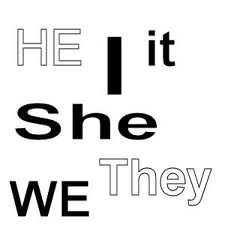
SPC-ELL: Pronouns
Self-Paced Collection of English Language Lessons
Make sure you "allow" blocked content and turn your speakers on to use this SoftChalk lesson. Watch the videos, listen to the recordings, and read the explanations on each page. Put your mouse over the bold words to read and see more. You can visit each page and try each activity as often as you want for practice.
When you want your answers to count, complete all activities and questions in order on each page, click "Check Answers" and then next page to continue.
Important - if you want to submit your scores, click the Finish button on the last page.

|
At the end of this lesson, you should be able to: 1. Identify subject, object, and possessive pronouns 2. Choose the correct pronoun in a sentence 3. Use reflexive pronouns correctly in a sentence |
Click on the arrow above to listen. Then, go to the next page.
To understand how to use pronouns in English, you must know what SUBJECTS, VERBS, and OBJECTS are. Try this "Self Check" to see what you already know.

Click on the arrow above to listen.
Every sentence in English must have a subject and a verb and be a complete thought. The subject of a sentence is ALWAYS a noun or pronoun.

Examples:
1. The children played.
2. They played.
Children & They are the subjects.
In addition to the subject and verb, many sentences also have an object.
3. The children played a game. [They played what? A game.]
4. Jose is reading an interesting book. [He's reading what? A book.]

Game and book are objects.
Try the Sorting Activity below to practice identifying subjects, verbs and objects in sentences.
Click on the arrow above to listen.
Pronouns are words that replace nouns. There are SUBJECT pronouns, OBJECT pronouns, and POSSESSIVE pronouns.
For example:
Q: How do you know which pronoun to choose?
A: Decide whether the noun you are replacing is 1st, 2nd, or 3rd person, singular or plural. Is it the subject or object of the sentence, or does it show possession? Then, choose the same kind of pronoun from the table.
|
Pronoun Table |
Subject Pronouns |
Object Pronouns |
Possessive Pronouns |
|---|---|---|---|
|
Singular 1st person 2nd person 3rd person |
I You He, she it |
Me You Him, her, it |
Mine Yours His, hers, its |
|
Plural 1st person 2nd person 3rd person |
We You They |
Us You Them |
Ours Yours Theirs |
For example:
1. Mr. Jones was a bad farmer. He did not take good care of his animals.
2. I absolutely love my new shoes! I'm going to wear them to the party next week.
3. The teacher is going to collect my essay in a minute. I hope she likes mine.
More examples:
Put your mouse over the purple words to see which kind of pronoun is used (see table) and its antecedent.
Try the Quiz Group below. (Make sure you click "Check Answers" when you are done.)
|
Pronoun Table |
Subject Pronouns |
Object Pronouns |
Possessive Pronouns |
|---|---|---|---|
|
Singular 1st person 2nd person 3rd person |
I You He, she it |
Me You Him, her, it |
Mine Yours His, hers, its |
|
Plural 1st person 2nd person 3rd person |
We You They |
Us You Them |
Ours Yours Theirs |

Click on the arrow above to listen.
|
A reflexive pronoun is used when the subject and object of the sentence are the SAME. For example:
|
|
|
I |
myself |
we |
ourselves |
|---|---|---|---|
|
you (singular) |
yourself |
you (plural) |
yourselves |
|
he,she,it |
himself, herself, itself |
they |
themselves |

Congratulations! You are now an expert on the Pronouns!
Important - if you want to submit your scores, click Finish on the last page.
Azar, B. & Hagen, S., (2009). Understanding and Using English Grammar (4th Edition). White Plains, NY: Pearson Longman.
Woodward, S. Fun with grammar. Retrieved from http://www.azargrammar.com/materials/FWG_TOC.html.